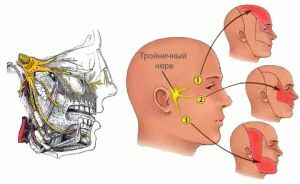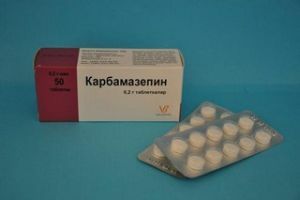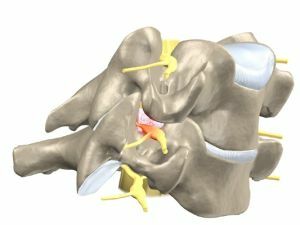 Pinching the nerve in the back - before you treat, you need a qualitative diagnosis.
Pinching the nerve in the back - before you treat, you need a qualitative diagnosis.
The "Bickford cord" is exactly the anatomical term - a thin line formed by the fusion of the anterior and posterior roots of each segment of the spinal cord, which forms the radicular nerve, which, passing the area of the thickening of the intervertebral ganglion and leaving the vertebrae( out of the hole -"Windows" between the neighboring vertebrae), gets here a very serious sounding name: a cable.
The content of the article
- The necessary anatomical reference
- What can be "snack" of the nerve
- Where can I expect a nerve infringement?
- Symptoms on the "horizon"
- Diagnosis and treatment entrust to the neurologist
- What if the backache suddenly caught?
- Traditional therapies
- What is recommended by folk healers
- infusions and tinctures
- Attention: fees!
- Your bath, sir!
- Ointments: gently rubbing
- Consequences "respond". ..
- Avoid infringement - both of the first and the repeated
The necessary anatomical information
Because it costs "frivolous" kanatik( or any of the named segments of the strand) "zatlet" - and now it's takencalled intercostal neuralgia( simulating a heart attack), or a lumbar "chamber", a lightning that pierces the lower half of the body to the very heel, or a head that tilts toward the neck.
Although both the character and the localization of pain depend on the level of damage, it is always a pain, in accordance with the Latin name of the root( radiculus) called radiculitis, if the spine is injured( or both), and funicular - in case of damage to the common cord. Either it bears the name radiculoneuritis( if the radicular, or spinal nerves, nerves are infringed), when the roots are involved in the process of the membranes, the disease is called meningoradiculitis.
But if the bikfordov cord can be easily extinguished or cut off the glowing end of it, then in the variant with the restrained spine or cord, thoughtless actions are not the place.
In addition to the fact that their defeat is in itself a serious problem, it can be "continued" to the vegetative ganglion bordering with the cord, and then to the peripheral nerve( radiculoneuritis) or to the plexus( the plexitis).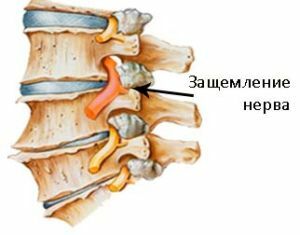
What should be guided with one of these pathologies, because nothing outside is "sticking out", and the threshold of perception of pain, which determines the clinical picture, is different for each person?
That's it for the diagnosis and treatment of such cases, there is a neurological service, and doctors-neurologists. An experienced specialist will accurately "filter out" the inherent "neurology" picture from a similar therapeutic, indicate the cause of pain in the back and explain the mechanism of its development, as well as its anatomical level:
- rootlet;
- cable;
- paravertebral nerve ganglion( "tuber", where there are switching of nerve impulses from some nerve wires to others);
- region of the spinal( spinal) nerve;
- the area of "spillage" of the plexus into nerve trunks, and the trunks - into separate nerves.
Because for each zone of defeat is inherent in its own clinic with its smallest nuances.
The physiological mechanism of the onset of radiculitis - damage to the spine, as well as similar structures of the "trunk" or "crown" - can easily be explained by a simple analogy with the wire between the door and the threshold - when the door closes, the wire is restrained in the right to move freely. And in general - is squashed.
"Wire" -the spine, swelling due to physical or chemical damage, also loses its freedom to occupy a certain space( in norm it, like any, even seemingly absolutely immobile organs, more or less "breathes", gently and imperceptibly expanding and contracting).In view of edema and squeezing, the function of these or those components of the "cable" of conductors is disrupted:
- motor;
- sensitive;
- is a vegetative.
The combination of the sensations tested determines the picture when the nerve is squeezed in the back, which manifests itself:
- with pain;
- local and general body reaction;
- is a disorder of the function of the affected person involved in the organ process.
Than the nerve of
can be "bitten". "Door" and "threshold" for the spinal nerve or nerve bundle are most often the neighboring vertebrae, which for one reason or another have become close to the inappropriate distance. This is the case of spinal injuries due to muscular overexertion from raising significant 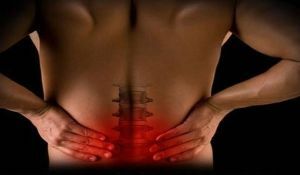 weights or because of a sharp increase in the axial load - falling to his feet from a hefty height, or simply an unsuccessful landing.
weights or because of a sharp increase in the axial load - falling to his feet from a hefty height, or simply an unsuccessful landing.
Pinching of the spinal nerve also occurs with the dull "teeth" of marginal osteophytes, which get tired of a permanent( years) stay in the same posture of the vertebrae in any of the spine sections( osteochondrosis).
The same as "not chewed" osteochondrosis, "milked" its continuation in the form of protrusion of the intervertebral disc, or its hernia.
The "tunnel syndrome" with compression of the nerve in a narrow space with solid walls and its more "soft" variant - myofascial syndrome( squeezing due to muscle spasm), and subluxations or displacement of the vertebrae, can become the causes of the infringement.
Pinching of the nerve can also be due to swelling more short-term - due to infection or intoxication.
Where can I expect a nerve impairment?
Infringement of the nerve in the cervical spine can occur due to spondylarthrosis or distortion( due to tearing or complete rupture of the joints between the ligaments), or subluxation of the vertebrae.
Pinching of the nerve in the thoracic spine, and in its lumbar segments can occur due to protrusion of the disc or injury. Or because of the "loading" of the spine overweight( especially in the absence of regular physical activity), as well as a tumor formed from his tissues.
Symptoms on the "horizon"
A definite symptom complex is formed depending on the level of the spine at which the lesion occurred, because the composition of the roots on different "horizons" includes a set of "wires" of a strictly defined purpose. 
If in most segments of the spinal cord the axons of motoneurons pass and the posterior part consists of the central processes of the sensitive cells, the anterior roots of the last cervical, all the thoracic and the first two lumbar segments are supplemented with vegetative nerve fibers coming from the lateral horns of the spinal cord.
This is important, because both the work of vessels and glands, and the level of trophic innervation of the striated and smooth muscles and other tissues are regulated by autonomic fibers in the composition of these nerves.
In turn, each spinal column that has left the spine gives rise to three or four branches: anterior, posterior, meningeal and white connective. And if the anterior and posterior branches of all other nerves are mixed, then the posterior branch of the first cervical consists exclusively of motor fibers.
From here, the symptoms that can accompany the pinching of the nerve in the back - a combination of varying severity:
- acute pain ( of varying duration and strength);
- sensitivity disorders ( from "numbness" and tingling to complete loss of local sensitivity);
- inconsistencies in the work of muscles ( in the form of muscle spasms, weakness in muscles);
- disorders of the function of the involved organs of ( in the case of the brain these are changes in blood pressure, dizziness, visual and hearing disorders due to disruption of the blood supply to the brain).
So, when one of the cervical spinal nerves is jammed, the pain is not limited to the neck. It extends to the nape of the neck, shoulder blades, shoulders, provokes headache, the appearance of "flies" and "ripples" in the eyes, dizziness, tinnitus, movement coordination disorders. In the chronic variant it continues with both movements and resting, and can even lead to memory deterioration.
 Pinching of the nerve in the thoracic spine gives rise to burning pain estimated by the patient as heart pain or symptoms that indicate digestive disorders( due to deterioration of the innervation of the gastrointestinal tract), pain in the chest appears when the muscles of this region are sharply strained( when coughing and sneezing).
Pinching of the nerve in the thoracic spine gives rise to burning pain estimated by the patient as heart pain or symptoms that indicate digestive disorders( due to deterioration of the innervation of the gastrointestinal tract), pain in the chest appears when the muscles of this region are sharply strained( when coughing and sneezing).
But especially "colorful" is the infringement of the spinal nerve, leading to lumbargia and sciatica.
The first expresses itself as a sharp "shooting" pain, which occurs suddenly when the body turns or its bends with the bending of the waist, causing the patient to freeze in place in a forced pose.
With sciatica, the pain projected on the sciatic nerve passages and reaching the foot is dull, aching, accompanied not only by "numbness" and tingling, but also can cause disorders of the pelvic organs and weakness in the muscles of the lower limbs. The process often takes on a chronic character, passing from neuropathy to neuritis of the sciatic nerve.
Diagnosis and treatment entrust to the neurologist
To put the right diagnosis on the basis of the questioning and examination of the patient, the X-ray and MRI of the spine, and then to prescribe an adequate treatment is only a matter of competence of the neuropathologist and no one else.
And if the goal of treatment is unique: to heal the patient, influencing the cause of suffering, then the methods of achieving it are many. The optimal result can be achieved by skillfully combining the techniques of traditional and "folk" medicine.
What should I do if my back suddenly stumbles?
Self-help tactics in case you are sharply covered by a wave of pain from pinching the nerve in the spine( back), it is worth to learn: 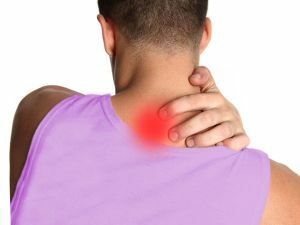
- without making sudden movements get to the bed( bed, sofa) or lie down directly on the floor;with the help of a series of successive, with breaks of movements to lie down on the back;
- after the abatement of pain, keeping the back in a position in which there is no pain, to make the movements in the reverse order: to stand on "all fours," then, using an assistant foot - to the feet;
- fix the back in a gentle position, using a tight bandage( towel, scarf);
- take an anesthetic( better class non-steroidal analgesics).
Correct behavior in the situation of the first occurrence of infringement is a measure of prevention of re-pinching, which is always "tougher" than the previous one.
Traditional methods of therapy
Classics of traditional treatment for pinching of the nerve in the back is the use of: 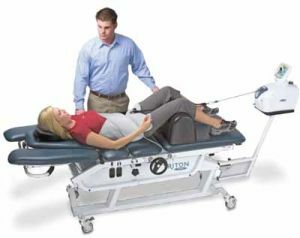
- medication analgesics;
- stretching therapy( with gradual giving the spine a natural position);
- fixation of the spine in the achieved position( using orthopedic devices);
- methods of physical therapy and physiotherapy;
- tissue and other therapy aimed at normalizing physiological processes in the musculoskeletal system.
A separate plan is the use of methods of manual therapy, acupuncture, yoga and similar methods.
In case of acute necessity, resort to surgical correction of the existing pathology of the spine.
From drug-analgesics, it is worth mentioning the drugs used as injections and per os( as well as in the form of rubbing) 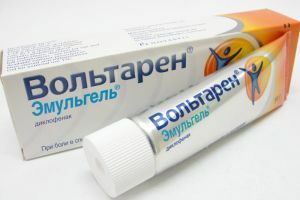 preparations of a nonsteroidal anti-inflammatory group - Ibuprofen, Voltaren, Diclofenac, Naproxen.
preparations of a nonsteroidal anti-inflammatory group - Ibuprofen, Voltaren, Diclofenac, Naproxen.
In problem cases, corticosteroids are used;as an aid, antihistamines, stimulators of metabolic processes are used to restore the functions of both the muscles and the damaged nerve( vitamins, biostimulants: aloe, vitreous and the like).
For stretching, special design of the bed is used, orthopedic corsets, Delbe rings or the Shantz collar are used to fix the spine in the achieved position.
A powerful remedy is the use of physiotherapy( UHF, iontophoresis, magnetotherapy), physical therapy( especially swimming) and therapeutic massage.
Exercise for pinching of the spinal nerve:
What is recommended by folk healers
"Folk medicine" offers to treat the pinching of the spinal nerve by the plants-painkillers "(gatherings, infusions), as well as rubbing, ointments based on them, the use of baths with them.
Infusions and tinctures
The externally tincture of lilac is prepared by infusing 500 ml of vodka with 1 glass of its flowers( for 2 weeks).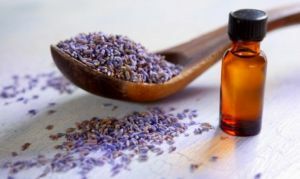
For ingestion, let's apply an infusion of cranberry leaves: in 1.5 cups of boiling water for an hour brewed 1 tsp.cranberry leaves;Drink 1/2 cup three times a day.
Juice of strawberry berries, covered with sugar( 1 glass of sugar / 5 glasses of berries) for 5 hours( before they extract juice), it is drunk for 1 tbsp.l.three times a day before meals.
Attention: fees!
Take: oregano herbs 5 parts, rose hips 3 hours, blackberry leaves 2 hours, leaves thyme 3 hours. All grind into powder;brew and drink like tea.
Taken in equal proportion of dill seeds, herb Leonurus and cumin seeds, as well as valerian root brewed in 1 tbsp.boiling water for a half an hour( taking 2 tablespoons of salt for brewing);drink on ½ st.three times a day.
Your bath, sir!
To prepare a bath from the bark of oak, 1 kg of raw material is boiled in 5 liters of water for a half an hour, after which, after filtering, add to the water baths with a temperature of no higher than 37 ° C.
No less effective is bathing from the leaves of black elderberry, herb of oregano, burdock, nettle, tansy, wheatgrass, horsetail, violet, thyme, juniper needles, black currant leaves, pine buds and cones of hops. Mixing everything in equal proportion, take 8 tbsp.l.mixture, add to boiling water( 2 liters) and boil for 10 minutes. After cooling to 37 ° C and filtering, add to the bath water.
Ointments: gently rubbing
Taken in a proportion of 1: 6, the mixture of needles of juniper and bay leaves is ground to a powder and mixed with 12 times the mass of butter( melted).Ointment relieves pain and muscle tension.
With the same purpose and use the ointment obtained by stirring 1 tbsp.l.cones of hops( ground to powder) in 1 tbsp.l.lard( or butter).
Consequences "respond". ..
Saying: ay!- incorrect behavior during the first episode of pinching the nerve and stubbornly ignoring the subsequent aggravations of the "young" while the process, you can eventually "hear the echo" of the remote consequences in the form: 
- cerebral manifestations of ( dizziness, headaches, noise and ringing in the ears, memory disorders, vision, coordination of movements, decreased performance) with infringement of the nerve( nerves) in the cervical region;
- of false "cardiac", "hepatic", "pancreatic" pains of at the onset of the disease with the onset of their actual pathology( as well as with increasing pulmonary ventilation disorders due to shaking of the indicated area and limitation of mobility in it) in the chronic course of the process in the thoracic spine segment;
- disorders of the gastrointestinal tract, pelvic pathology , lowering the performance of the lower limbs with infringement of the nerves of the lumbar or sacral department.
Given that pinching of the spinal nerve can be the "first bell" from the protrusion of the intervertebral disc, if you ignore its first manifestations, you can eventually get a complication in the form of a hernia, leading to the need for urgent surgical intervention.
Avoid infringement - both the first and the second
Maintaining a mobile life with the most active participation of the spine in it allows not only not to "absorb" the extra "kilogram mass", but also to "massage the movement" of all the organs of the body. And the spine - including.
No less important is the mastery of the "art of relaxation" in the most tension-prone environment. For many hours of "ossification" at the computer, which ends in a sudden "explosion" of glee at the "success", "breakthrough", "triumph" of the company in the form of joyful "jumps to the ceiling," jumping bodies against each other and convulsive embraces -pinched nerve. Or vertebral hernia.
It should be remembered that the correct biomechanics of movements is the essence of the life of the body. A living body. Alive in all respects!


